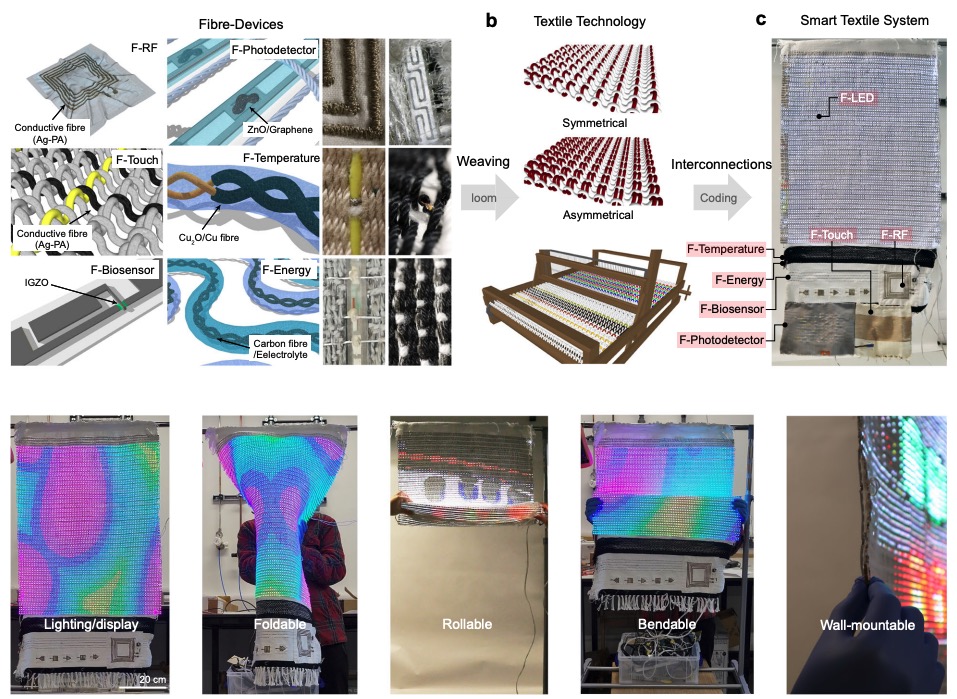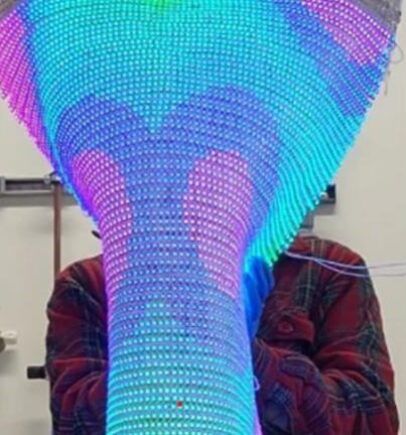
Could Drapes And Curtains Be Future Display Canvases? Maybe …
March 31, 2022 by Dave Haynes
A pile of different institutions – including universities, institutes and the labs of private companies – have people looking into ways to blend LED light emitters with fabric to create news kinds of displays based around smart textiles. The core of it is woven fabric that incorporates electronic devices – LEDs but also things like sensors and energy harvesters.
Display Daily has a post up that digs into research findings for “Smart textile lighting/display system with multifunctional fibre devices for large scale smart home and IoT applications.”
The research paper is way the hell over my head, but Display Daily boils it down and simplifies at least some of was published in Nature Communications.
Despite the considerable progress in smart textile technology that has been accomplished to date, the team states in their article that “a large scale approach for a smart display system with integrated multifunctional devices in traditional textile platforms has yet to be demonstrated.”
Addressing this issue was the focus of research undertaken by the team. A recent article on this topic published by the team was entitled “Smart textile lighting/display system with multifunctional fibre devices for large scale smart home and IoT applications.” It was published in Nature Communications (2022) and can be found here.
In this article, the team reported on development of means to produce woven fabric that integrates red, green and blue LEDs, wireless energy harvesting and energy storage. Smart sensors were also integrated providing capabilities for touch sensing, temperature sensing, environmental monitoring, biosignal monitoring and photo detection. The team demonstrated their new approach by integrated these electronic capabilities into a series of 46 inch prototype smart fabrics.
Researchers have come up with prototypes that solder LEDs to super-thin and flexible copper wiring and weave them in with cotton fibers.

The LEDs in the prototypes were mounted onto a 4 mm wide flexible copper fiber on which the electrodes were patterned by chemical copper etching. Solder paste was applied to each LED mounting location. After placing LEDs aligned with soldering paste on a copper fiber, hot-dry reflowing (< 250 °C, solidifying solders) was used to secure the LEDs. The copper fibers were then woven with cotton fibers using a line by line asymmetry, the ratio being 1:3 for the LED versus cotton thread. This weaving approach was used to avoid distortion when images are displayed on the fabric.
Several prototype smart fabrics were developed. Smart fabrics were fabricated having arrays of red green and blue LEDs in two sizes: 84 x 76 and 120 x 65. Each of these array size was fabricated in a version with a pixel pitch of 5 mm and with a pixel pitch of 7 mm. Features and specifications of the smart fabric include the following:
- Energy harvesting was accomplished using a square spiral 13.56 MHz RF antenna
- Power consumption was on the order of 35 W
- Fabric thickness was less than 5 mm
- Operating voltage was less than 3 V
- Luminance was greater than 104 cd/m2 for RGB
- Colors purity and brightness were maintained under change of fabric shape
The research concludes that: “Our systematic design and integration strategies are transformational and provide the foundation for realizing highly functional smart lighting/display textiles over large area for revolutionary applications on smart homes and internet of things.”
Pixel pitches of 5mm and 7mm are pretty good and applicable to real visual display jobs, and 5mm for fabric thickness would suggest a finished product would be pretty light. The use-cases for this don’t leap to mind, but there are lots of super-clever people who design built environments who might be intrigued by this sort of thing as a material for a changeable, experiential space.
I can’t quite envision this as something for apparel, but some designer would be all over this for an over-the-top dress at the annual Met Gala in New York. I get my clothes at Costco (pfffft) and am not expecting to pick up a dynamic sweatshirt there anytime soon.
Interesting stuff, though!



Leave a comment